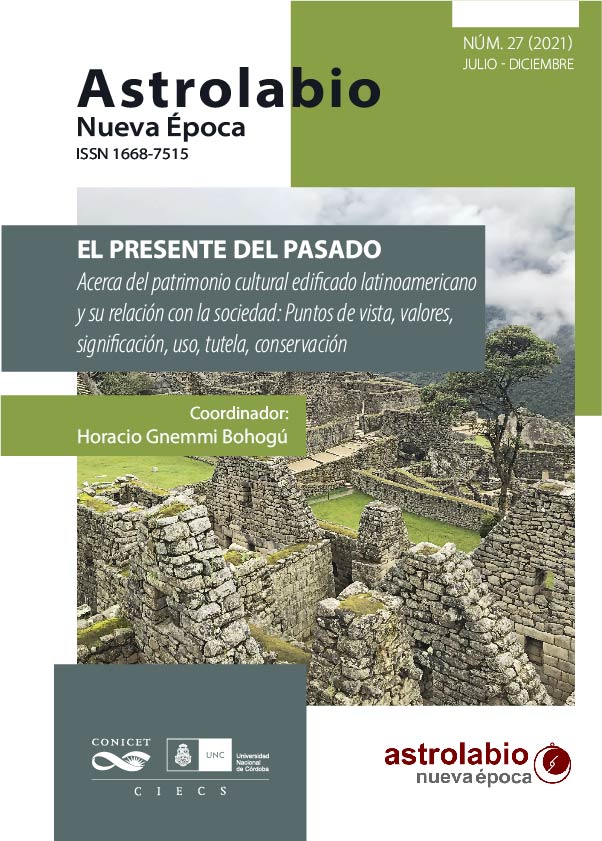Reading practices: Contributions for a reflecting and intervening upon built patrimony
Main Article Content
Abstract
A relevant feature of Modernity is the bureaucratic formalization of relationships and administrative procedures, something that has had significant consequences in the field of built architectonic heritage. On the one side, it is aimed at an administrated handling of these works, but on the other, this affects the relationship of subjects regarding these works. In this paper I propose a cluster of elements with a philosophical basis, which may serve as roadmap for a comprehensive approach to built heritage from a Latin American perspective. First, I will propose to understand the relationship to edified built heritage under the form of a reading exercise. This approach is complemented by some main traits of hermeneutics: The different intentions to be found in interpretation regarding the work, the fusion of horizons, and the narration that relates personal historicity with the work itself, are some main hermeneutical contributions for a relationship of meaningful understanding of built heritage. Besides this hermeneutic perspective, the pragmatic approach to the double relationship of truth and action regarding the effects of the work, allows to deal with the cognitive and valorative limitations arising from the formal approach of Modernity to built heritage.
Downloads
Article Details

This work is licensed under a Creative Commons Attribution-NonCommercial-ShareAlike 4.0 International License.
Astrolabio, Nueva Época está protegida bajo licencia Licencia Creative Commons Atribución-NoComercial-CompartirIgual 4.0 Internacional. La propiedad intelectual de los artículos pertenece a los autores y los derechos de edición y publicación a la revista. Los artículos publicados podrán ser usados libremente para propósitos científicos y académicos, siempre y cuando se realice una correcta citación de los mismos. Cualquier persona física o jurídica que desee reimprimir parte o la totalidad de algún artículo, deberá obtener permiso escrito de los editores de Astrolabio Nueva Época, quien lo otorgará con el consentimiento del autor.
References
ADORNO, Theodor. (2005). Dialéctica negativa. En Obra Completa, vol. 6, pp. 7-394. Madrid: Akal. (Edición original, 1966.)
ASSELBORN, Carlos; CRUZ, Gustavo; y PACHECO, Oscar. (2009). Liberación, estética y política. Córdoba: EDUCC.
BRANDI, Cesare. (1995). Teoría de la restauración. Madrid: Alianza. (Edición original, 1963.)
CAMPEOTTO, Fabio y VIALE, Claudio. (2019). “Giro estético y vanguardia. Acerca de la influencia del pensamiento de John Dewey en artistas norteamericanos”. Pensando. Revista de Filosofía, 10, 20, 58-78.
COMETTI, Jean-Pierre. (2018). Conservar/Restaurar. La obra de arte en la época de su preservación técnica. Buenos Aires: Biblos.
DE CERTEAU, Michel. (2000). La invención de lo cotidiano, volumen 1. México: Universidad Iberoamericana. (Edición original, 1980.)
DEWEY, John. (2008). El arte como experiencia. Barcelona: Paidós. (Edición original, 1934.)
DUSSEL, Enrique. (2015). Filosofía de la cultura y trans-modernidad. México: Universidad Autónoma de la Ciudad de México.
DUSSEL, Enrique. (2017). “Siete hipótesis para una «estética de la liberación»”. Cuadernos Filosóficos. Segunda Época, XIV, 30-63. Recuperado de: https://rephip.unr.edu.ar/bitstream/handle/2133/13798/DUSSEL-E.-Siete-hip%C3%B3tesis.pdf?sequence=3&isAllowed=y [consulta: 13 de octubre de 2020].
ECO, Umberto. (1992). Los límites de la interpretación. Barcelona: Lumen.
FONTI, Diego. (2017). “Arquitectura y escritura. Acerca de la pregunta ¿por qué escribir es parte del trabajo arquitectónico?”. Pensum, 3, 1-11.
FREIJOMIL, Andrés. (2009). “Les pratiques de la lecture chez Michel de Certeau”. Cahiers du Centre de Recherches Historiques, 44, 109-134. Recuperado de: https://journals.openedition.org/ccrh/3533#bodyftn18 [consulta: 19 de setiembre de 2020].
FREIJOMIL, Andrés. (2017). “El nuevo mundo como «página en blanco». Elementos para una historia de las representaciones de América Latina en la obra de Michel de Certeau”. Pelícano, 3, 31-38. Recuperado de: https://www.academia.edu/43594280/El_nuevo_mundo_como_p%C3%A1gina_en_blanco_Elementos_para_una_historia_de_las_representaciones_de_Am%C3%A9rica_Latina_en_la_obra_de_Michel_de_Certeau [consulta: 5 de octubre de 2020].
GADAMER, Hans-Georg. (1999). Verdad y método, volumen 1. Salamanca: Sígueme. (Edición original, 1975.)
HABERMAS, Jürgen. (1988). Ensayos políticos. Madrid: Península.
HABERMAS, Jürgen. (2019). Auch eine Geschichte der Philosophie. Band 2. Berlin: Suhrkamp.
HEIDEGGER, Martin. (1994). La pregunta por la técnica. En Conferencias y artículos, pp. 9-38. Barcelona: Ediciones del Serbal. (Edición original, 1954.)
HEIDEGGER, Martin. (2003). Ser y tiempo. Madrid: Trotta. (Edición original, 1927.)
ICOMOS. (1964). Carta de Venecia. Recuperado de https://www.icomos.org/charters/venice_sp.pdf [consulta: 3 de setiembre de 2020].
ICOMOS. (1967). Normas de Quito. Recuperado de https://www.icomos.org/charters/quito.htm [consulta: 3 de setiembre de 2020].
KOSELLECK, Reinhart. (2011). Modernidad, culto a la muerte y memoria nacional. Madrid: Centro de Estudios Políticos y Constitucionales.
NORA, Pierre. (2008). Pierre Nora en Les lieux de Mémoire. Montevideo: Trilce. (Ediciones originales de los textos aquí reunidos, 1984, 1987 y 1992.)
ORTIZ, Gustavo. (2013). América Latina. ¿Una modernidad diferente? Córdoba: EDUCC.
OSTERHAMMEL, Jürgen. (2014). The Transformation of the World. Princeton: Princeton University Press.
PEIRCE, Charles Sanders. (1971). Mi alegato a favor del pragmatismo. Buenos Aires: Aguilar. (Ediciones originales de los textos, 1877 y 1878.)
RICOEUR, Paul. (2009). Tiempo y narración (3 tomos). México: Siglo XXI. (Edición original, 1985.)
RIEGL, Aloïs. (1987). El culto moderno a los monumentos. Madrid: Visor. (Edición original, 1903.)
RUFINETTI, Edgar. (2018). La racionalidad práctica en el debate Habermas-Gadamer. Villa María: Eduvim.
SANTABÁRBARA MORERA, Carlota. (2018). “Difusión y repercusión de la teoría de la restauración de Cesare Brandi”. Cuadernos de Arte de la Universidad de Granada, 49, 285-303.
STEINER, George. (1980). Después de Babel. Aspectos del lenguaje y la traducción. México: FCE. (Edición original, 1975.)
UNESCO. (2014). Indicadores Unesco de cultura para el desarrollo. París: Unesco. Recuperado de: https://es.unesco.org/creativity/sites/creativity/files/iucd_manual_metodologico_1.pdf [consulta: 25 de setiembre de 2020].
WEBER, Max. (2014). Economía y sociedad. México: FCE. (Edición original, 1922.)

